Systematic Review: Yoga vs Physical Therapy for Lymphedema Reduction
VerifiedAdded on 2023/01/09
|32
|12486
|90
Literature Review
AI Summary
This literature review systematically examines the effectiveness of yoga as a traditional physical therapy for reducing lymphedema in patients who have undergone treatment for head and neck cancer. It begins by defining lymphedema, its physiology, symptoms, and causes, particularly in the context of cancer treatment. The review then delves into the benefits of yoga, highlighting its role in maintaining physical and mental health, controlling breath rates, diet, and promoting positive thinking. By analyzing various studies, the review aims to determine if yoga is a viable alternative or complement to traditional physical therapy for managing lymphedema, and it seeks to provide interventions and recommendations to improve health outcomes for affected patients.

Healthcare Leadership
Paraphrase This Document
Need a fresh take? Get an instant paraphrase of this document with our AI Paraphraser
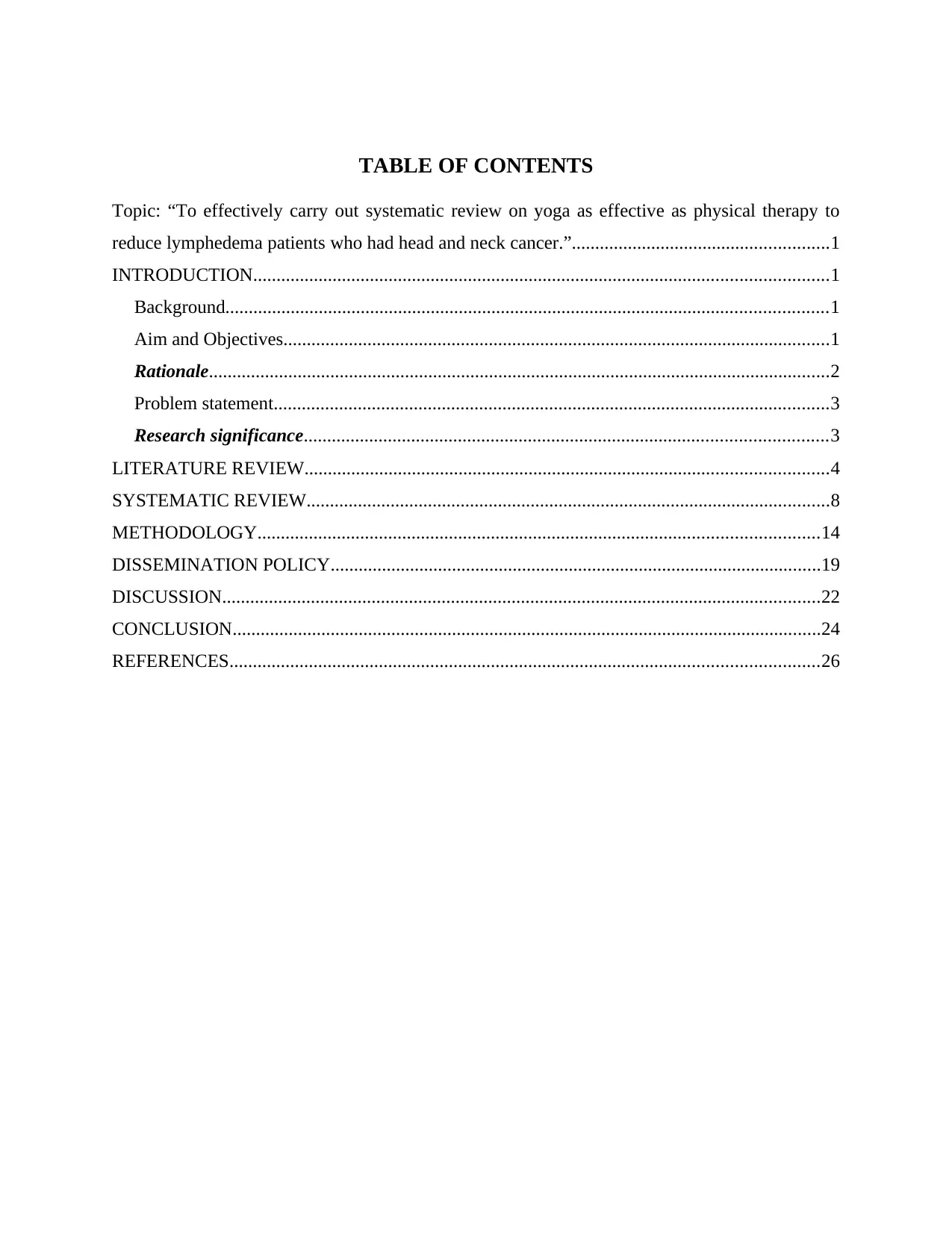
TABLE OF CONTENTS
Topic: “To effectively carry out systematic review on yoga as effective as physical therapy to
reduce lymphedema patients who had head and neck cancer.”.......................................................1
INTRODUCTION...........................................................................................................................1
Background.................................................................................................................................1
Aim and Objectives.....................................................................................................................1
Rationale.....................................................................................................................................2
Problem statement.......................................................................................................................3
Research significance................................................................................................................3
LITERATURE REVIEW................................................................................................................4
SYSTEMATIC REVIEW................................................................................................................8
METHODOLOGY........................................................................................................................14
DISSEMINATION POLICY.........................................................................................................19
DISCUSSION................................................................................................................................22
CONCLUSION..............................................................................................................................24
REFERENCES..............................................................................................................................26
Topic: “To effectively carry out systematic review on yoga as effective as physical therapy to
reduce lymphedema patients who had head and neck cancer.”.......................................................1
INTRODUCTION...........................................................................................................................1
Background.................................................................................................................................1
Aim and Objectives.....................................................................................................................1
Rationale.....................................................................................................................................2
Problem statement.......................................................................................................................3
Research significance................................................................................................................3
LITERATURE REVIEW................................................................................................................4
SYSTEMATIC REVIEW................................................................................................................8
METHODOLOGY........................................................................................................................14
DISSEMINATION POLICY.........................................................................................................19
DISCUSSION................................................................................................................................22
CONCLUSION..............................................................................................................................24
REFERENCES..............................................................................................................................26
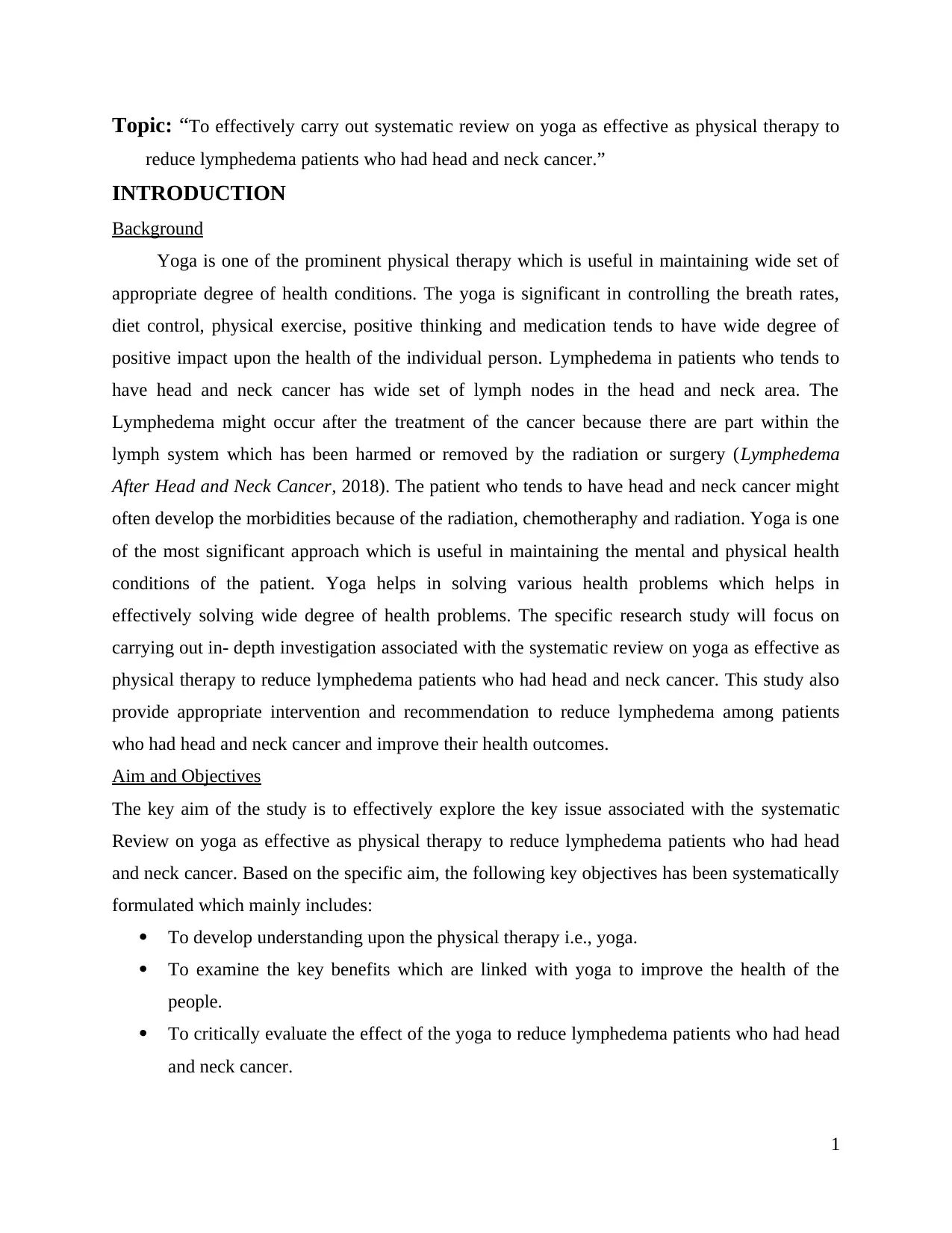
Topic: “To effectively carry out systematic review on yoga as effective as physical therapy to
reduce lymphedema patients who had head and neck cancer.”
INTRODUCTION
Background
Yoga is one of the prominent physical therapy which is useful in maintaining wide set of
appropriate degree of health conditions. The yoga is significant in controlling the breath rates,
diet control, physical exercise, positive thinking and medication tends to have wide degree of
positive impact upon the health of the individual person. Lymphedema in patients who tends to
have head and neck cancer has wide set of lymph nodes in the head and neck area. The
Lymphedema might occur after the treatment of the cancer because there are part within the
lymph system which has been harmed or removed by the radiation or surgery (Lymphedema
After Head and Neck Cancer, 2018). The patient who tends to have head and neck cancer might
often develop the morbidities because of the radiation, chemotheraphy and radiation. Yoga is one
of the most significant approach which is useful in maintaining the mental and physical health
conditions of the patient. Yoga helps in solving various health problems which helps in
effectively solving wide degree of health problems. The specific research study will focus on
carrying out in- depth investigation associated with the systematic review on yoga as effective as
physical therapy to reduce lymphedema patients who had head and neck cancer. This study also
provide appropriate intervention and recommendation to reduce lymphedema among patients
who had head and neck cancer and improve their health outcomes.
Aim and Objectives
The key aim of the study is to effectively explore the key issue associated with the systematic
Review on yoga as effective as physical therapy to reduce lymphedema patients who had head
and neck cancer. Based on the specific aim, the following key objectives has been systematically
formulated which mainly includes:
To develop understanding upon the physical therapy i.e., yoga.
To examine the key benefits which are linked with yoga to improve the health of the
people.
To critically evaluate the effect of the yoga to reduce lymphedema patients who had head
and neck cancer.
1
reduce lymphedema patients who had head and neck cancer.”
INTRODUCTION
Background
Yoga is one of the prominent physical therapy which is useful in maintaining wide set of
appropriate degree of health conditions. The yoga is significant in controlling the breath rates,
diet control, physical exercise, positive thinking and medication tends to have wide degree of
positive impact upon the health of the individual person. Lymphedema in patients who tends to
have head and neck cancer has wide set of lymph nodes in the head and neck area. The
Lymphedema might occur after the treatment of the cancer because there are part within the
lymph system which has been harmed or removed by the radiation or surgery (Lymphedema
After Head and Neck Cancer, 2018). The patient who tends to have head and neck cancer might
often develop the morbidities because of the radiation, chemotheraphy and radiation. Yoga is one
of the most significant approach which is useful in maintaining the mental and physical health
conditions of the patient. Yoga helps in solving various health problems which helps in
effectively solving wide degree of health problems. The specific research study will focus on
carrying out in- depth investigation associated with the systematic review on yoga as effective as
physical therapy to reduce lymphedema patients who had head and neck cancer. This study also
provide appropriate intervention and recommendation to reduce lymphedema among patients
who had head and neck cancer and improve their health outcomes.
Aim and Objectives
The key aim of the study is to effectively explore the key issue associated with the systematic
Review on yoga as effective as physical therapy to reduce lymphedema patients who had head
and neck cancer. Based on the specific aim, the following key objectives has been systematically
formulated which mainly includes:
To develop understanding upon the physical therapy i.e., yoga.
To examine the key benefits which are linked with yoga to improve the health of the
people.
To critically evaluate the effect of the yoga to reduce lymphedema patients who had head
and neck cancer.
1
⊘ This is a preview!⊘
Do you want full access?
Subscribe today to unlock all pages.

Trusted by 1+ million students worldwide

To provide appropriate intervention and recommendation to reduce lymphedema among
patients who had head and neck cancer and improve their health outcomes.
Research Questions
How to examine the understanding associated with yoga?
What are the key benefits which are linked with yoga to improve the health of the
people?
What is the effect of the yoga to reduce lymphedema patients who had head and neck
cancer?
What are appropriate intervention and recommendation to reduce lymphedema among
patients who had head and neck cancer and improve their health outcomes?
Hypothesis
Hypothesis 1
Alternative hypothesis (N1): There is no basic understanding about yoga.
Hypothesis 2
Alternative hypothesis (N1): There are no benefits of yoga as traditional therapy for health of
people.
Hypothesis 3
Alternative hypothesis (N1): There is no positive impact of yoga as traditional therapy in order to
reduce lymphedema in patients having head and neck cancer treatment.
Hypothesis 4
Alternative hypothesis (N1): The role of care practitioners doesn’t exist to provide traditional
therapy of yoga to improve health.
Rationale
The researcher of the study in turn tends to mainly focus on selecting this topic because
of the academic interest of the researcher. The researcher focuses on gaining wide set of in-
depth understanding associated with analysing the effectiveness of yoga as traditional physical
therapy in reducing lymphedema in patients who had head and neck cancer treatment. Another
key reason for selecting this topic is to gain current set of knowledge and this is the current issue.
This study will be highly significant in gaining in- depth set of understanding on the specific
subject matter. Another key reason for selecting this as a research topic is to because of the own
2
patients who had head and neck cancer and improve their health outcomes.
Research Questions
How to examine the understanding associated with yoga?
What are the key benefits which are linked with yoga to improve the health of the
people?
What is the effect of the yoga to reduce lymphedema patients who had head and neck
cancer?
What are appropriate intervention and recommendation to reduce lymphedema among
patients who had head and neck cancer and improve their health outcomes?
Hypothesis
Hypothesis 1
Alternative hypothesis (N1): There is no basic understanding about yoga.
Hypothesis 2
Alternative hypothesis (N1): There are no benefits of yoga as traditional therapy for health of
people.
Hypothesis 3
Alternative hypothesis (N1): There is no positive impact of yoga as traditional therapy in order to
reduce lymphedema in patients having head and neck cancer treatment.
Hypothesis 4
Alternative hypothesis (N1): The role of care practitioners doesn’t exist to provide traditional
therapy of yoga to improve health.
Rationale
The researcher of the study in turn tends to mainly focus on selecting this topic because
of the academic interest of the researcher. The researcher focuses on gaining wide set of in-
depth understanding associated with analysing the effectiveness of yoga as traditional physical
therapy in reducing lymphedema in patients who had head and neck cancer treatment. Another
key reason for selecting this topic is to gain current set of knowledge and this is the current issue.
This study will be highly significant in gaining in- depth set of understanding on the specific
subject matter. Another key reason for selecting this as a research topic is to because of the own
2
Paraphrase This Document
Need a fresh take? Get an instant paraphrase of this document with our AI Paraphraser
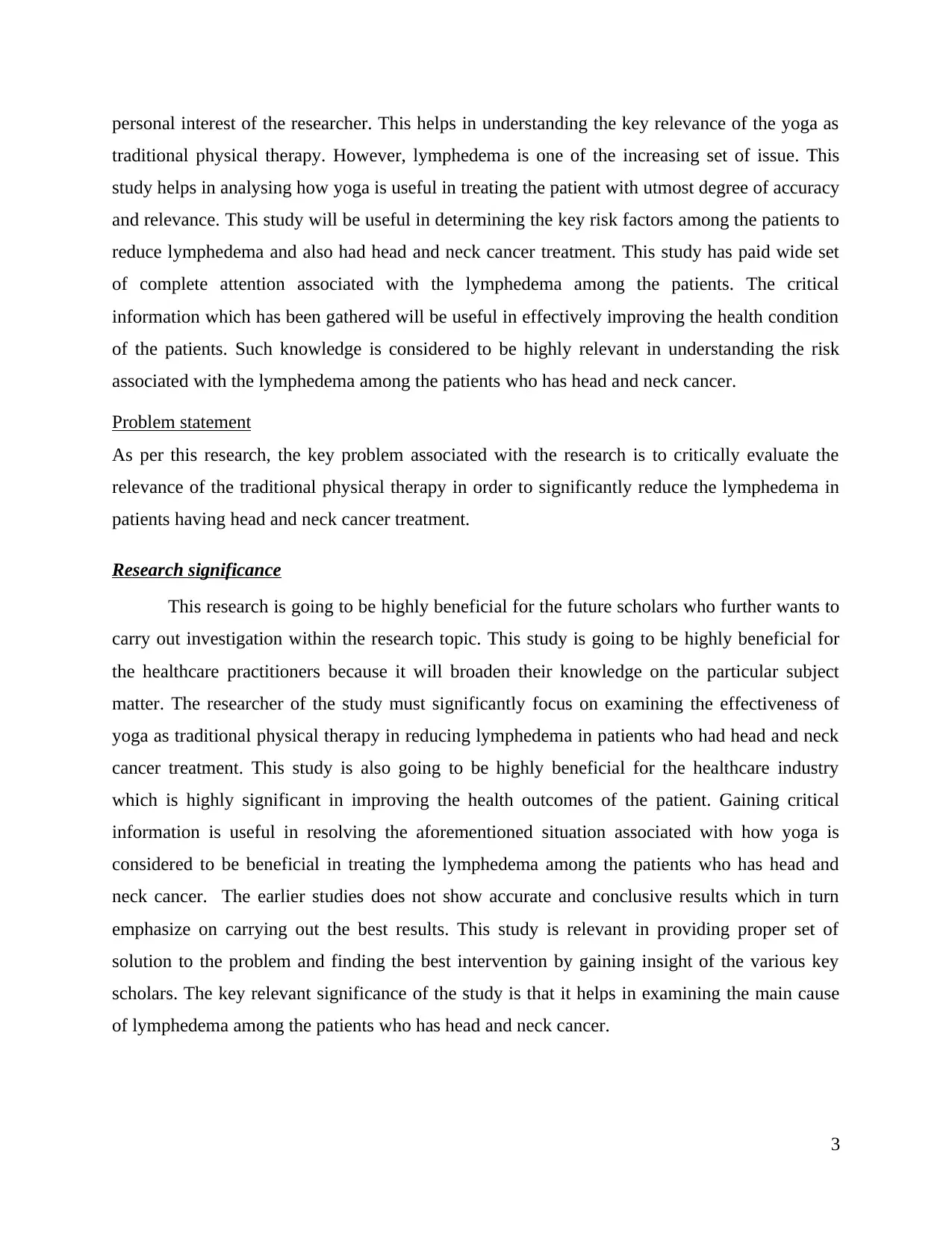
personal interest of the researcher. This helps in understanding the key relevance of the yoga as
traditional physical therapy. However, lymphedema is one of the increasing set of issue. This
study helps in analysing how yoga is useful in treating the patient with utmost degree of accuracy
and relevance. This study will be useful in determining the key risk factors among the patients to
reduce lymphedema and also had head and neck cancer treatment. This study has paid wide set
of complete attention associated with the lymphedema among the patients. The critical
information which has been gathered will be useful in effectively improving the health condition
of the patients. Such knowledge is considered to be highly relevant in understanding the risk
associated with the lymphedema among the patients who has head and neck cancer.
Problem statement
As per this research, the key problem associated with the research is to critically evaluate the
relevance of the traditional physical therapy in order to significantly reduce the lymphedema in
patients having head and neck cancer treatment.
Research significance
This research is going to be highly beneficial for the future scholars who further wants to
carry out investigation within the research topic. This study is going to be highly beneficial for
the healthcare practitioners because it will broaden their knowledge on the particular subject
matter. The researcher of the study must significantly focus on examining the effectiveness of
yoga as traditional physical therapy in reducing lymphedema in patients who had head and neck
cancer treatment. This study is also going to be highly beneficial for the healthcare industry
which is highly significant in improving the health outcomes of the patient. Gaining critical
information is useful in resolving the aforementioned situation associated with how yoga is
considered to be beneficial in treating the lymphedema among the patients who has head and
neck cancer. The earlier studies does not show accurate and conclusive results which in turn
emphasize on carrying out the best results. This study is relevant in providing proper set of
solution to the problem and finding the best intervention by gaining insight of the various key
scholars. The key relevant significance of the study is that it helps in examining the main cause
of lymphedema among the patients who has head and neck cancer.
3
traditional physical therapy. However, lymphedema is one of the increasing set of issue. This
study helps in analysing how yoga is useful in treating the patient with utmost degree of accuracy
and relevance. This study will be useful in determining the key risk factors among the patients to
reduce lymphedema and also had head and neck cancer treatment. This study has paid wide set
of complete attention associated with the lymphedema among the patients. The critical
information which has been gathered will be useful in effectively improving the health condition
of the patients. Such knowledge is considered to be highly relevant in understanding the risk
associated with the lymphedema among the patients who has head and neck cancer.
Problem statement
As per this research, the key problem associated with the research is to critically evaluate the
relevance of the traditional physical therapy in order to significantly reduce the lymphedema in
patients having head and neck cancer treatment.
Research significance
This research is going to be highly beneficial for the future scholars who further wants to
carry out investigation within the research topic. This study is going to be highly beneficial for
the healthcare practitioners because it will broaden their knowledge on the particular subject
matter. The researcher of the study must significantly focus on examining the effectiveness of
yoga as traditional physical therapy in reducing lymphedema in patients who had head and neck
cancer treatment. This study is also going to be highly beneficial for the healthcare industry
which is highly significant in improving the health outcomes of the patient. Gaining critical
information is useful in resolving the aforementioned situation associated with how yoga is
considered to be beneficial in treating the lymphedema among the patients who has head and
neck cancer. The earlier studies does not show accurate and conclusive results which in turn
emphasize on carrying out the best results. This study is relevant in providing proper set of
solution to the problem and finding the best intervention by gaining insight of the various key
scholars. The key relevant significance of the study is that it helps in examining the main cause
of lymphedema among the patients who has head and neck cancer.
3
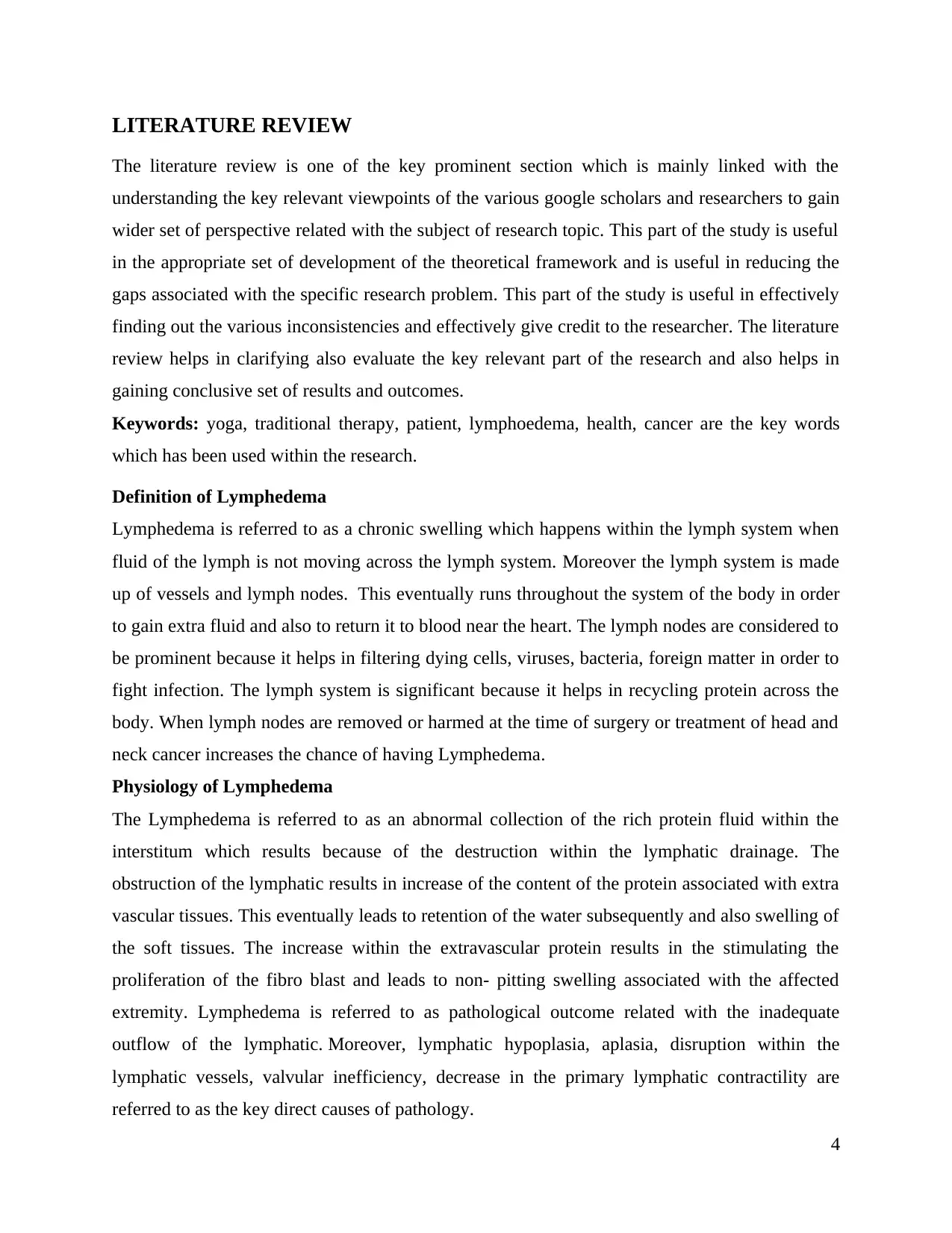
LITERATURE REVIEW
The literature review is one of the key prominent section which is mainly linked with the
understanding the key relevant viewpoints of the various google scholars and researchers to gain
wider set of perspective related with the subject of research topic. This part of the study is useful
in the appropriate set of development of the theoretical framework and is useful in reducing the
gaps associated with the specific research problem. This part of the study is useful in effectively
finding out the various inconsistencies and effectively give credit to the researcher. The literature
review helps in clarifying also evaluate the key relevant part of the research and also helps in
gaining conclusive set of results and outcomes.
Keywords: yoga, traditional therapy, patient, lymphoedema, health, cancer are the key words
which has been used within the research.
Definition of Lymphedema
Lymphedema is referred to as a chronic swelling which happens within the lymph system when
fluid of the lymph is not moving across the lymph system. Moreover the lymph system is made
up of vessels and lymph nodes. This eventually runs throughout the system of the body in order
to gain extra fluid and also to return it to blood near the heart. The lymph nodes are considered to
be prominent because it helps in filtering dying cells, viruses, bacteria, foreign matter in order to
fight infection. The lymph system is significant because it helps in recycling protein across the
body. When lymph nodes are removed or harmed at the time of surgery or treatment of head and
neck cancer increases the chance of having Lymphedema.
Physiology of Lymphedema
The Lymphedema is referred to as an abnormal collection of the rich protein fluid within the
interstitum which results because of the destruction within the lymphatic drainage. The
obstruction of the lymphatic results in increase of the content of the protein associated with extra
vascular tissues. This eventually leads to retention of the water subsequently and also swelling of
the soft tissues. The increase within the extravascular protein results in the stimulating the
proliferation of the fibro blast and leads to non- pitting swelling associated with the affected
extremity. Lymphedema is referred to as pathological outcome related with the inadequate
outflow of the lymphatic. Moreover, lymphatic hypoplasia, aplasia, disruption within the
lymphatic vessels, valvular inefficiency, decrease in the primary lymphatic contractility are
referred to as the key direct causes of pathology.
4
The literature review is one of the key prominent section which is mainly linked with the
understanding the key relevant viewpoints of the various google scholars and researchers to gain
wider set of perspective related with the subject of research topic. This part of the study is useful
in the appropriate set of development of the theoretical framework and is useful in reducing the
gaps associated with the specific research problem. This part of the study is useful in effectively
finding out the various inconsistencies and effectively give credit to the researcher. The literature
review helps in clarifying also evaluate the key relevant part of the research and also helps in
gaining conclusive set of results and outcomes.
Keywords: yoga, traditional therapy, patient, lymphoedema, health, cancer are the key words
which has been used within the research.
Definition of Lymphedema
Lymphedema is referred to as a chronic swelling which happens within the lymph system when
fluid of the lymph is not moving across the lymph system. Moreover the lymph system is made
up of vessels and lymph nodes. This eventually runs throughout the system of the body in order
to gain extra fluid and also to return it to blood near the heart. The lymph nodes are considered to
be prominent because it helps in filtering dying cells, viruses, bacteria, foreign matter in order to
fight infection. The lymph system is significant because it helps in recycling protein across the
body. When lymph nodes are removed or harmed at the time of surgery or treatment of head and
neck cancer increases the chance of having Lymphedema.
Physiology of Lymphedema
The Lymphedema is referred to as an abnormal collection of the rich protein fluid within the
interstitum which results because of the destruction within the lymphatic drainage. The
obstruction of the lymphatic results in increase of the content of the protein associated with extra
vascular tissues. This eventually leads to retention of the water subsequently and also swelling of
the soft tissues. The increase within the extravascular protein results in the stimulating the
proliferation of the fibro blast and leads to non- pitting swelling associated with the affected
extremity. Lymphedema is referred to as pathological outcome related with the inadequate
outflow of the lymphatic. Moreover, lymphatic hypoplasia, aplasia, disruption within the
lymphatic vessels, valvular inefficiency, decrease in the primary lymphatic contractility are
referred to as the key direct causes of pathology.
4
⊘ This is a preview!⊘
Do you want full access?
Subscribe today to unlock all pages.

Trusted by 1+ million students worldwide
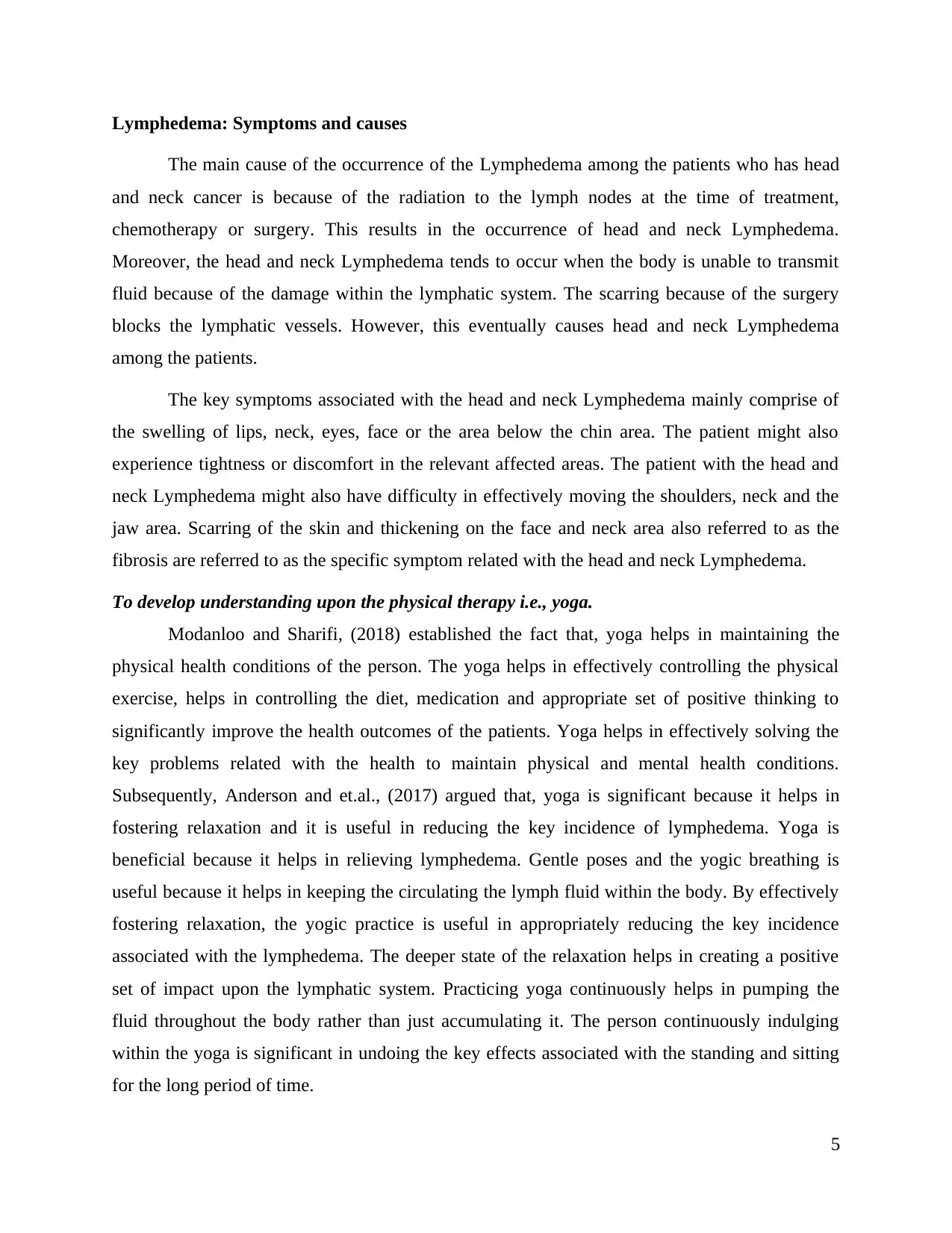
Lymphedema: Symptoms and causes
The main cause of the occurrence of the Lymphedema among the patients who has head
and neck cancer is because of the radiation to the lymph nodes at the time of treatment,
chemotherapy or surgery. This results in the occurrence of head and neck Lymphedema.
Moreover, the head and neck Lymphedema tends to occur when the body is unable to transmit
fluid because of the damage within the lymphatic system. The scarring because of the surgery
blocks the lymphatic vessels. However, this eventually causes head and neck Lymphedema
among the patients.
The key symptoms associated with the head and neck Lymphedema mainly comprise of
the swelling of lips, neck, eyes, face or the area below the chin area. The patient might also
experience tightness or discomfort in the relevant affected areas. The patient with the head and
neck Lymphedema might also have difficulty in effectively moving the shoulders, neck and the
jaw area. Scarring of the skin and thickening on the face and neck area also referred to as the
fibrosis are referred to as the specific symptom related with the head and neck Lymphedema.
To develop understanding upon the physical therapy i.e., yoga.
Modanloo and Sharifi, (2018) established the fact that, yoga helps in maintaining the
physical health conditions of the person. The yoga helps in effectively controlling the physical
exercise, helps in controlling the diet, medication and appropriate set of positive thinking to
significantly improve the health outcomes of the patients. Yoga helps in effectively solving the
key problems related with the health to maintain physical and mental health conditions.
Subsequently, Anderson and et.al., (2017) argued that, yoga is significant because it helps in
fostering relaxation and it is useful in reducing the key incidence of lymphedema. Yoga is
beneficial because it helps in relieving lymphedema. Gentle poses and the yogic breathing is
useful because it helps in keeping the circulating the lymph fluid within the body. By effectively
fostering relaxation, the yogic practice is useful in appropriately reducing the key incidence
associated with the lymphedema. The deeper state of the relaxation helps in creating a positive
set of impact upon the lymphatic system. Practicing yoga continuously helps in pumping the
fluid throughout the body rather than just accumulating it. The person continuously indulging
within the yoga is significant in undoing the key effects associated with the standing and sitting
for the long period of time.
5
The main cause of the occurrence of the Lymphedema among the patients who has head
and neck cancer is because of the radiation to the lymph nodes at the time of treatment,
chemotherapy or surgery. This results in the occurrence of head and neck Lymphedema.
Moreover, the head and neck Lymphedema tends to occur when the body is unable to transmit
fluid because of the damage within the lymphatic system. The scarring because of the surgery
blocks the lymphatic vessels. However, this eventually causes head and neck Lymphedema
among the patients.
The key symptoms associated with the head and neck Lymphedema mainly comprise of
the swelling of lips, neck, eyes, face or the area below the chin area. The patient might also
experience tightness or discomfort in the relevant affected areas. The patient with the head and
neck Lymphedema might also have difficulty in effectively moving the shoulders, neck and the
jaw area. Scarring of the skin and thickening on the face and neck area also referred to as the
fibrosis are referred to as the specific symptom related with the head and neck Lymphedema.
To develop understanding upon the physical therapy i.e., yoga.
Modanloo and Sharifi, (2018) established the fact that, yoga helps in maintaining the
physical health conditions of the person. The yoga helps in effectively controlling the physical
exercise, helps in controlling the diet, medication and appropriate set of positive thinking to
significantly improve the health outcomes of the patients. Yoga helps in effectively solving the
key problems related with the health to maintain physical and mental health conditions.
Subsequently, Anderson and et.al., (2017) argued that, yoga is significant because it helps in
fostering relaxation and it is useful in reducing the key incidence of lymphedema. Yoga is
beneficial because it helps in relieving lymphedema. Gentle poses and the yogic breathing is
useful because it helps in keeping the circulating the lymph fluid within the body. By effectively
fostering relaxation, the yogic practice is useful in appropriately reducing the key incidence
associated with the lymphedema. The deeper state of the relaxation helps in creating a positive
set of impact upon the lymphatic system. Practicing yoga continuously helps in pumping the
fluid throughout the body rather than just accumulating it. The person continuously indulging
within the yoga is significant in undoing the key effects associated with the standing and sitting
for the long period of time.
5
Paraphrase This Document
Need a fresh take? Get an instant paraphrase of this document with our AI Paraphraser
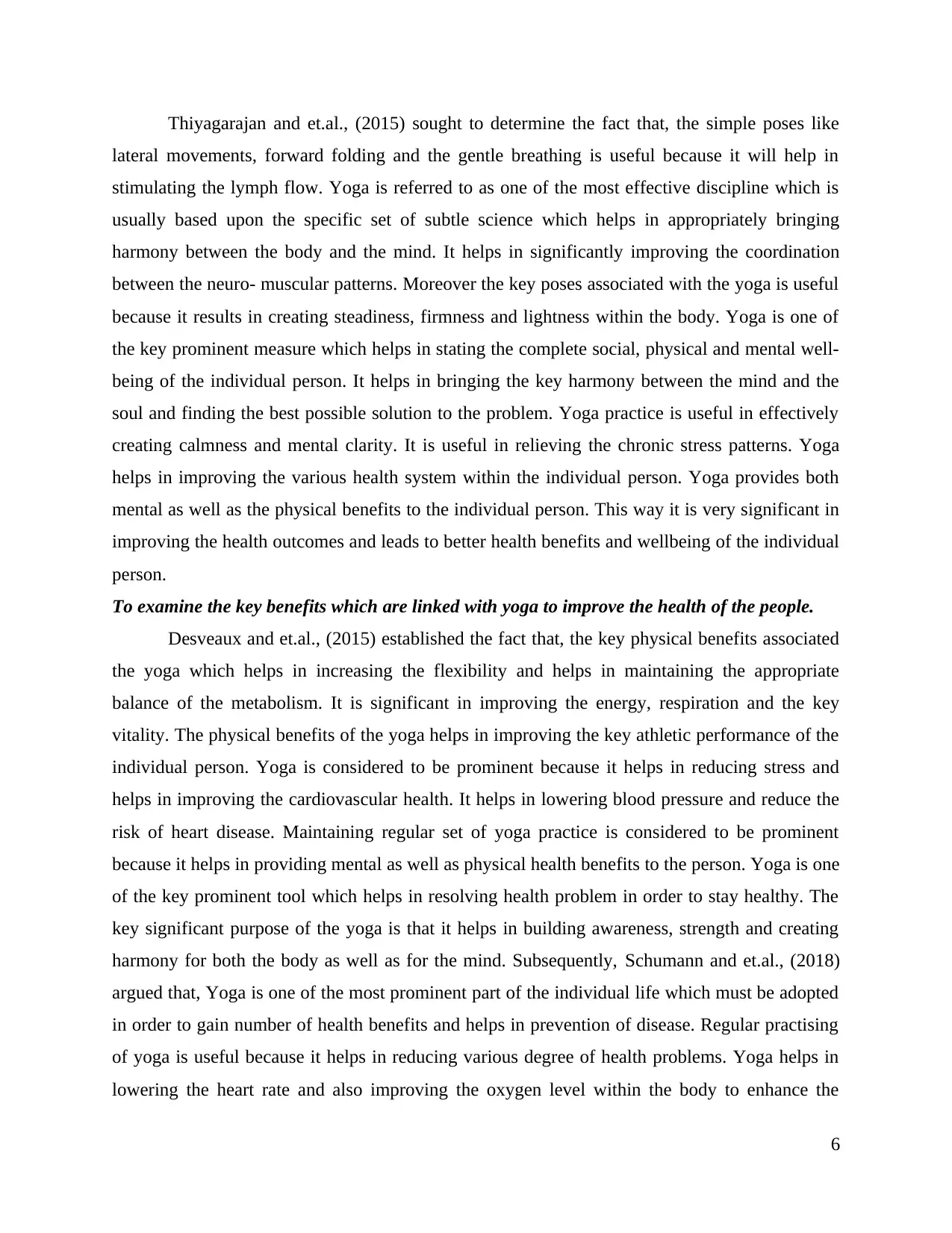
Thiyagarajan and et.al., (2015) sought to determine the fact that, the simple poses like
lateral movements, forward folding and the gentle breathing is useful because it will help in
stimulating the lymph flow. Yoga is referred to as one of the most effective discipline which is
usually based upon the specific set of subtle science which helps in appropriately bringing
harmony between the body and the mind. It helps in significantly improving the coordination
between the neuro- muscular patterns. Moreover the key poses associated with the yoga is useful
because it results in creating steadiness, firmness and lightness within the body. Yoga is one of
the key prominent measure which helps in stating the complete social, physical and mental well-
being of the individual person. It helps in bringing the key harmony between the mind and the
soul and finding the best possible solution to the problem. Yoga practice is useful in effectively
creating calmness and mental clarity. It is useful in relieving the chronic stress patterns. Yoga
helps in improving the various health system within the individual person. Yoga provides both
mental as well as the physical benefits to the individual person. This way it is very significant in
improving the health outcomes and leads to better health benefits and wellbeing of the individual
person.
To examine the key benefits which are linked with yoga to improve the health of the people.
Desveaux and et.al., (2015) established the fact that, the key physical benefits associated
the yoga which helps in increasing the flexibility and helps in maintaining the appropriate
balance of the metabolism. It is significant in improving the energy, respiration and the key
vitality. The physical benefits of the yoga helps in improving the key athletic performance of the
individual person. Yoga is considered to be prominent because it helps in reducing stress and
helps in improving the cardiovascular health. It helps in lowering blood pressure and reduce the
risk of heart disease. Maintaining regular set of yoga practice is considered to be prominent
because it helps in providing mental as well as physical health benefits to the person. Yoga is one
of the key prominent tool which helps in resolving health problem in order to stay healthy. The
key significant purpose of the yoga is that it helps in building awareness, strength and creating
harmony for both the body as well as for the mind. Subsequently, Schumann and et.al., (2018)
argued that, Yoga is one of the most prominent part of the individual life which must be adopted
in order to gain number of health benefits and helps in prevention of disease. Regular practising
of yoga is useful because it helps in reducing various degree of health problems. Yoga helps in
lowering the heart rate and also improving the oxygen level within the body to enhance the
6
lateral movements, forward folding and the gentle breathing is useful because it will help in
stimulating the lymph flow. Yoga is referred to as one of the most effective discipline which is
usually based upon the specific set of subtle science which helps in appropriately bringing
harmony between the body and the mind. It helps in significantly improving the coordination
between the neuro- muscular patterns. Moreover the key poses associated with the yoga is useful
because it results in creating steadiness, firmness and lightness within the body. Yoga is one of
the key prominent measure which helps in stating the complete social, physical and mental well-
being of the individual person. It helps in bringing the key harmony between the mind and the
soul and finding the best possible solution to the problem. Yoga practice is useful in effectively
creating calmness and mental clarity. It is useful in relieving the chronic stress patterns. Yoga
helps in improving the various health system within the individual person. Yoga provides both
mental as well as the physical benefits to the individual person. This way it is very significant in
improving the health outcomes and leads to better health benefits and wellbeing of the individual
person.
To examine the key benefits which are linked with yoga to improve the health of the people.
Desveaux and et.al., (2015) established the fact that, the key physical benefits associated
the yoga which helps in increasing the flexibility and helps in maintaining the appropriate
balance of the metabolism. It is significant in improving the energy, respiration and the key
vitality. The physical benefits of the yoga helps in improving the key athletic performance of the
individual person. Yoga is considered to be prominent because it helps in reducing stress and
helps in improving the cardiovascular health. It helps in lowering blood pressure and reduce the
risk of heart disease. Maintaining regular set of yoga practice is considered to be prominent
because it helps in providing mental as well as physical health benefits to the person. Yoga is one
of the key prominent tool which helps in resolving health problem in order to stay healthy. The
key significant purpose of the yoga is that it helps in building awareness, strength and creating
harmony for both the body as well as for the mind. Subsequently, Schumann and et.al., (2018)
argued that, Yoga is one of the most prominent part of the individual life which must be adopted
in order to gain number of health benefits and helps in prevention of disease. Regular practising
of yoga is useful because it helps in reducing various degree of health problems. Yoga helps in
lowering the heart rate and also improving the oxygen level within the body to enhance the
6
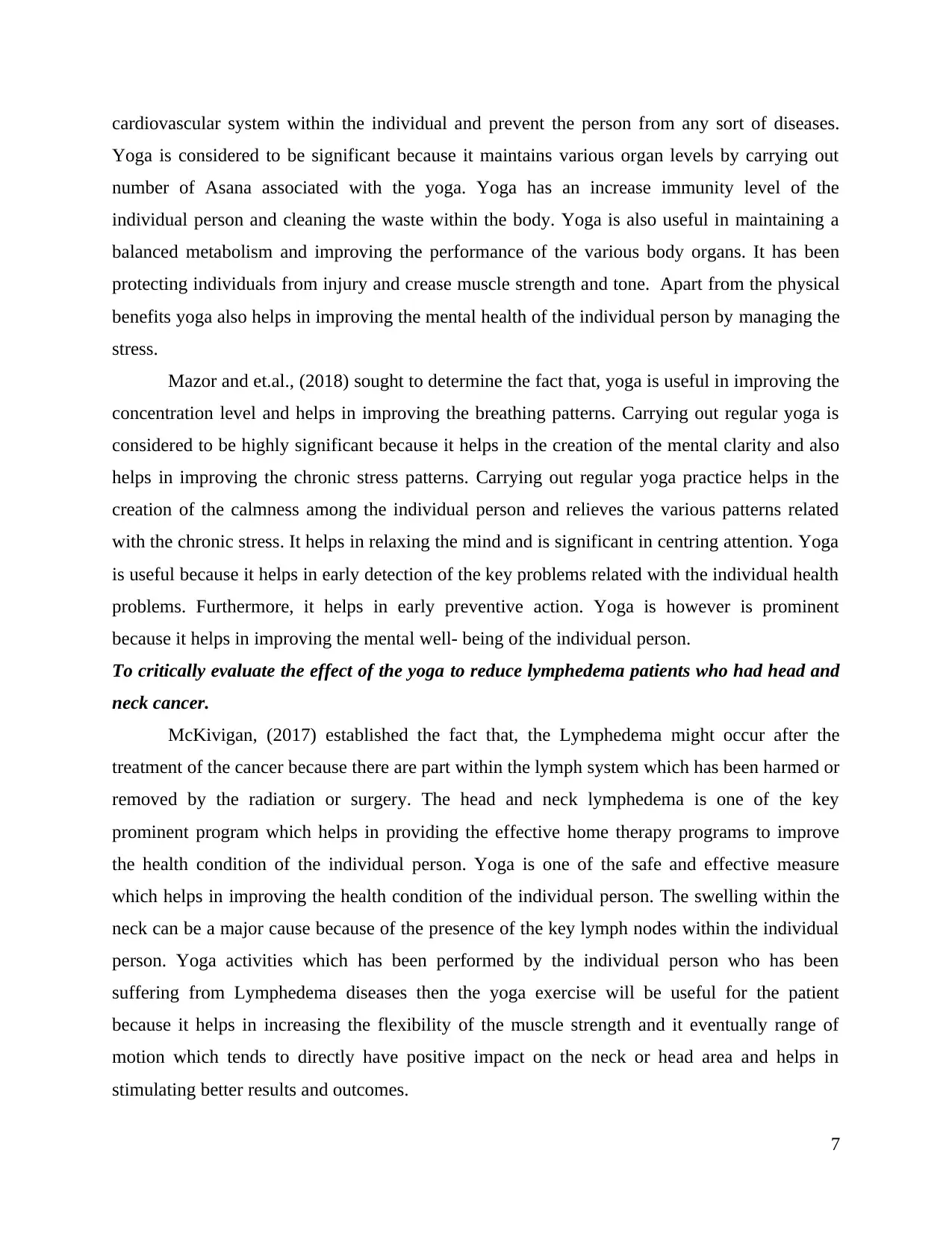
cardiovascular system within the individual and prevent the person from any sort of diseases.
Yoga is considered to be significant because it maintains various organ levels by carrying out
number of Asana associated with the yoga. Yoga has an increase immunity level of the
individual person and cleaning the waste within the body. Yoga is also useful in maintaining a
balanced metabolism and improving the performance of the various body organs. It has been
protecting individuals from injury and crease muscle strength and tone. Apart from the physical
benefits yoga also helps in improving the mental health of the individual person by managing the
stress.
Mazor and et.al., (2018) sought to determine the fact that, yoga is useful in improving the
concentration level and helps in improving the breathing patterns. Carrying out regular yoga is
considered to be highly significant because it helps in the creation of the mental clarity and also
helps in improving the chronic stress patterns. Carrying out regular yoga practice helps in the
creation of the calmness among the individual person and relieves the various patterns related
with the chronic stress. It helps in relaxing the mind and is significant in centring attention. Yoga
is useful because it helps in early detection of the key problems related with the individual health
problems. Furthermore, it helps in early preventive action. Yoga is however is prominent
because it helps in improving the mental well- being of the individual person.
To critically evaluate the effect of the yoga to reduce lymphedema patients who had head and
neck cancer.
McKivigan, (2017) established the fact that, the Lymphedema might occur after the
treatment of the cancer because there are part within the lymph system which has been harmed or
removed by the radiation or surgery. The head and neck lymphedema is one of the key
prominent program which helps in providing the effective home therapy programs to improve
the health condition of the individual person. Yoga is one of the safe and effective measure
which helps in improving the health condition of the individual person. The swelling within the
neck can be a major cause because of the presence of the key lymph nodes within the individual
person. Yoga activities which has been performed by the individual person who has been
suffering from Lymphedema diseases then the yoga exercise will be useful for the patient
because it helps in increasing the flexibility of the muscle strength and it eventually range of
motion which tends to directly have positive impact on the neck or head area and helps in
stimulating better results and outcomes.
7
Yoga is considered to be significant because it maintains various organ levels by carrying out
number of Asana associated with the yoga. Yoga has an increase immunity level of the
individual person and cleaning the waste within the body. Yoga is also useful in maintaining a
balanced metabolism and improving the performance of the various body organs. It has been
protecting individuals from injury and crease muscle strength and tone. Apart from the physical
benefits yoga also helps in improving the mental health of the individual person by managing the
stress.
Mazor and et.al., (2018) sought to determine the fact that, yoga is useful in improving the
concentration level and helps in improving the breathing patterns. Carrying out regular yoga is
considered to be highly significant because it helps in the creation of the mental clarity and also
helps in improving the chronic stress patterns. Carrying out regular yoga practice helps in the
creation of the calmness among the individual person and relieves the various patterns related
with the chronic stress. It helps in relaxing the mind and is significant in centring attention. Yoga
is useful because it helps in early detection of the key problems related with the individual health
problems. Furthermore, it helps in early preventive action. Yoga is however is prominent
because it helps in improving the mental well- being of the individual person.
To critically evaluate the effect of the yoga to reduce lymphedema patients who had head and
neck cancer.
McKivigan, (2017) established the fact that, the Lymphedema might occur after the
treatment of the cancer because there are part within the lymph system which has been harmed or
removed by the radiation or surgery. The head and neck lymphedema is one of the key
prominent program which helps in providing the effective home therapy programs to improve
the health condition of the individual person. Yoga is one of the safe and effective measure
which helps in improving the health condition of the individual person. The swelling within the
neck can be a major cause because of the presence of the key lymph nodes within the individual
person. Yoga activities which has been performed by the individual person who has been
suffering from Lymphedema diseases then the yoga exercise will be useful for the patient
because it helps in increasing the flexibility of the muscle strength and it eventually range of
motion which tends to directly have positive impact on the neck or head area and helps in
stimulating better results and outcomes.
7
⊘ This is a preview!⊘
Do you want full access?
Subscribe today to unlock all pages.

Trusted by 1+ million students worldwide
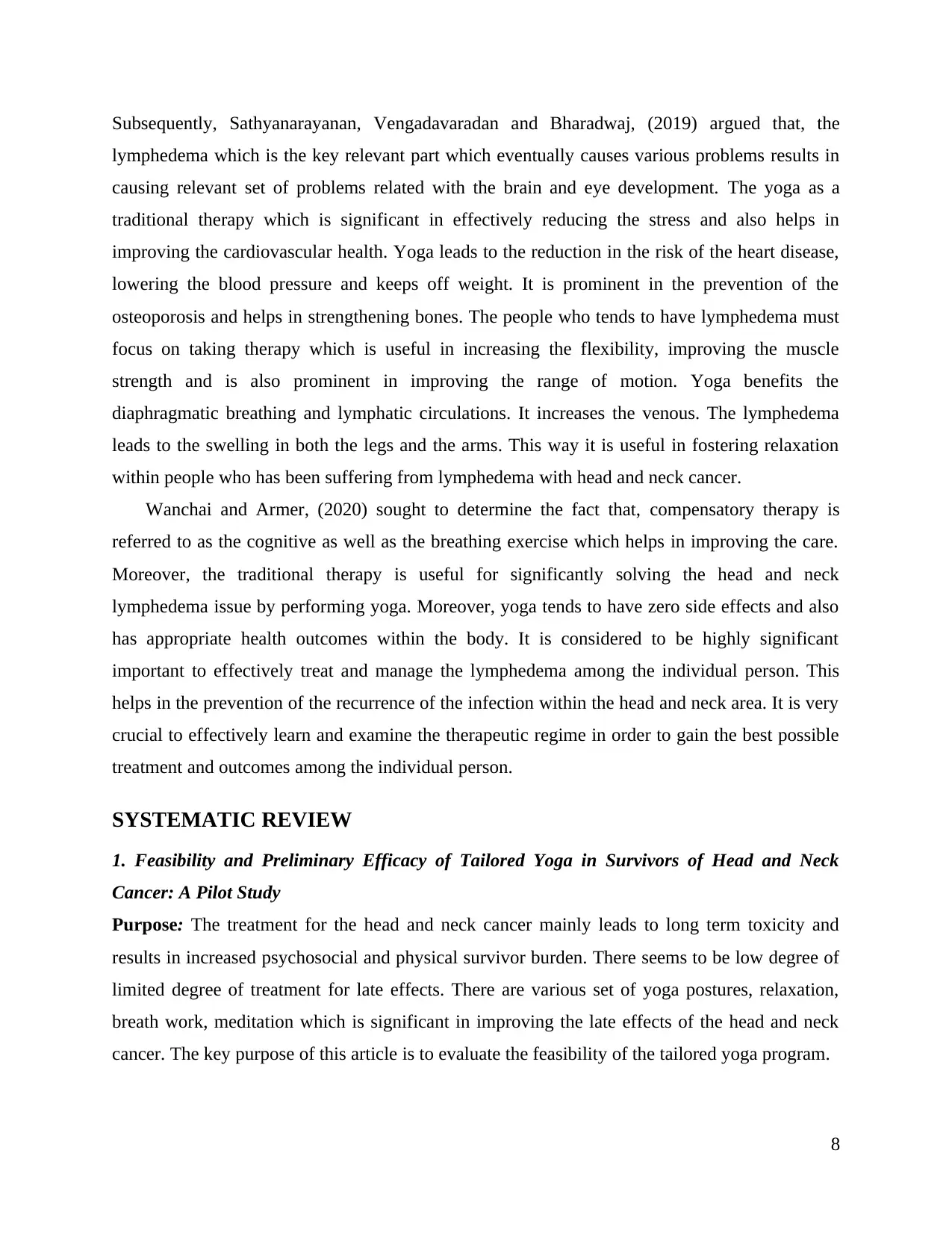
Subsequently, Sathyanarayanan, Vengadavaradan and Bharadwaj, (2019) argued that, the
lymphedema which is the key relevant part which eventually causes various problems results in
causing relevant set of problems related with the brain and eye development. The yoga as a
traditional therapy which is significant in effectively reducing the stress and also helps in
improving the cardiovascular health. Yoga leads to the reduction in the risk of the heart disease,
lowering the blood pressure and keeps off weight. It is prominent in the prevention of the
osteoporosis and helps in strengthening bones. The people who tends to have lymphedema must
focus on taking therapy which is useful in increasing the flexibility, improving the muscle
strength and is also prominent in improving the range of motion. Yoga benefits the
diaphragmatic breathing and lymphatic circulations. It increases the venous. The lymphedema
leads to the swelling in both the legs and the arms. This way it is useful in fostering relaxation
within people who has been suffering from lymphedema with head and neck cancer.
Wanchai and Armer, (2020) sought to determine the fact that, compensatory therapy is
referred to as the cognitive as well as the breathing exercise which helps in improving the care.
Moreover, the traditional therapy is useful for significantly solving the head and neck
lymphedema issue by performing yoga. Moreover, yoga tends to have zero side effects and also
has appropriate health outcomes within the body. It is considered to be highly significant
important to effectively treat and manage the lymphedema among the individual person. This
helps in the prevention of the recurrence of the infection within the head and neck area. It is very
crucial to effectively learn and examine the therapeutic regime in order to gain the best possible
treatment and outcomes among the individual person.
SYSTEMATIC REVIEW
1. Feasibility and Preliminary Efficacy of Tailored Yoga in Survivors of Head and Neck
Cancer: A Pilot Study
Purpose: The treatment for the head and neck cancer mainly leads to long term toxicity and
results in increased psychosocial and physical survivor burden. There seems to be low degree of
limited degree of treatment for late effects. There are various set of yoga postures, relaxation,
breath work, meditation which is significant in improving the late effects of the head and neck
cancer. The key purpose of this article is to evaluate the feasibility of the tailored yoga program.
8
lymphedema which is the key relevant part which eventually causes various problems results in
causing relevant set of problems related with the brain and eye development. The yoga as a
traditional therapy which is significant in effectively reducing the stress and also helps in
improving the cardiovascular health. Yoga leads to the reduction in the risk of the heart disease,
lowering the blood pressure and keeps off weight. It is prominent in the prevention of the
osteoporosis and helps in strengthening bones. The people who tends to have lymphedema must
focus on taking therapy which is useful in increasing the flexibility, improving the muscle
strength and is also prominent in improving the range of motion. Yoga benefits the
diaphragmatic breathing and lymphatic circulations. It increases the venous. The lymphedema
leads to the swelling in both the legs and the arms. This way it is useful in fostering relaxation
within people who has been suffering from lymphedema with head and neck cancer.
Wanchai and Armer, (2020) sought to determine the fact that, compensatory therapy is
referred to as the cognitive as well as the breathing exercise which helps in improving the care.
Moreover, the traditional therapy is useful for significantly solving the head and neck
lymphedema issue by performing yoga. Moreover, yoga tends to have zero side effects and also
has appropriate health outcomes within the body. It is considered to be highly significant
important to effectively treat and manage the lymphedema among the individual person. This
helps in the prevention of the recurrence of the infection within the head and neck area. It is very
crucial to effectively learn and examine the therapeutic regime in order to gain the best possible
treatment and outcomes among the individual person.
SYSTEMATIC REVIEW
1. Feasibility and Preliminary Efficacy of Tailored Yoga in Survivors of Head and Neck
Cancer: A Pilot Study
Purpose: The treatment for the head and neck cancer mainly leads to long term toxicity and
results in increased psychosocial and physical survivor burden. There seems to be low degree of
limited degree of treatment for late effects. There are various set of yoga postures, relaxation,
breath work, meditation which is significant in improving the late effects of the head and neck
cancer. The key purpose of this article is to evaluate the feasibility of the tailored yoga program.
8
Paraphrase This Document
Need a fresh take? Get an instant paraphrase of this document with our AI Paraphraser

Methods: This study has been carried out through randomized control study related with the
yoga naïve head and neck cancer survivors. Hatrha yoga intervention has been carried out for the
participants for 8 weeks. The researcher has used to effectively generate estimates through mixed
general linear models.
Results: Approximately 73 individuals has been screened and 40 people were considered to be
eligible. There is a feasibility within the study. The satisfaction rate at the time of the study was
significantly high. Moreover, the efficacy measures tend to indicate that, there seems to be
potential degree of benefit for the shoulder range of motion and anxiety. No adverse or any kind
of suicidal ideation has been identified.
Conclusion: It has been concluded that, the tailored hatha yoga program is considered to be
highly feasible and is also highly efficacious for the head and neck cancer survivors (Feasibility
and Preliminary Efficacy of Tailored Yoga in Survivors of Head and Neck Cancer: A Pilot Study,
2018). This is a useful measure for the post- treatment of the head and neck cancer survivors.
2. Head and neck lymphedema: what is the physical therapy approach? A literature review.
Introduction: The head and neck lymphedema is referred to as a complex and chronic
complications with the key potential to occur any set of functional, physical, emotional and
social impairment. Head and neck lymphedema results in wide set of complications which tends
to manifest feeling of tightness and heaviness with permanent set of discomfort in specific part
of the body.
Objective: One of the prominent objective of the study is to examine the key approaches
to the physical therapy which has been used in significantly treating head and neck cancer
associated lymphedema.
Method: In order to significantly carry out the study, an effective bibliographic search
has been carried out. This research has been significantly carried out in the year 2012 in
February and March month. The data has been collected within the electronic database and
books. Use of SCIELO, Cochrane, LILACS, MEDLINE, PEDro, and BDTD (Head and neck
lymphedema: what is the physical therapy approach? A literature review, 2016). The keywords
mainly includes lymphedema, head and neck cancer, treatment and physical therapy.
Results and Discussion: Early assessment and diagnosis is significant in properly
managing the healthcare problems and is signifiacnt in treating lymphedema. However, the
9
yoga naïve head and neck cancer survivors. Hatrha yoga intervention has been carried out for the
participants for 8 weeks. The researcher has used to effectively generate estimates through mixed
general linear models.
Results: Approximately 73 individuals has been screened and 40 people were considered to be
eligible. There is a feasibility within the study. The satisfaction rate at the time of the study was
significantly high. Moreover, the efficacy measures tend to indicate that, there seems to be
potential degree of benefit for the shoulder range of motion and anxiety. No adverse or any kind
of suicidal ideation has been identified.
Conclusion: It has been concluded that, the tailored hatha yoga program is considered to be
highly feasible and is also highly efficacious for the head and neck cancer survivors (Feasibility
and Preliminary Efficacy of Tailored Yoga in Survivors of Head and Neck Cancer: A Pilot Study,
2018). This is a useful measure for the post- treatment of the head and neck cancer survivors.
2. Head and neck lymphedema: what is the physical therapy approach? A literature review.
Introduction: The head and neck lymphedema is referred to as a complex and chronic
complications with the key potential to occur any set of functional, physical, emotional and
social impairment. Head and neck lymphedema results in wide set of complications which tends
to manifest feeling of tightness and heaviness with permanent set of discomfort in specific part
of the body.
Objective: One of the prominent objective of the study is to examine the key approaches
to the physical therapy which has been used in significantly treating head and neck cancer
associated lymphedema.
Method: In order to significantly carry out the study, an effective bibliographic search
has been carried out. This research has been significantly carried out in the year 2012 in
February and March month. The data has been collected within the electronic database and
books. Use of SCIELO, Cochrane, LILACS, MEDLINE, PEDro, and BDTD (Head and neck
lymphedema: what is the physical therapy approach? A literature review, 2016). The keywords
mainly includes lymphedema, head and neck cancer, treatment and physical therapy.
Results and Discussion: Early assessment and diagnosis is significant in properly
managing the healthcare problems and is signifiacnt in treating lymphedema. However, the
9
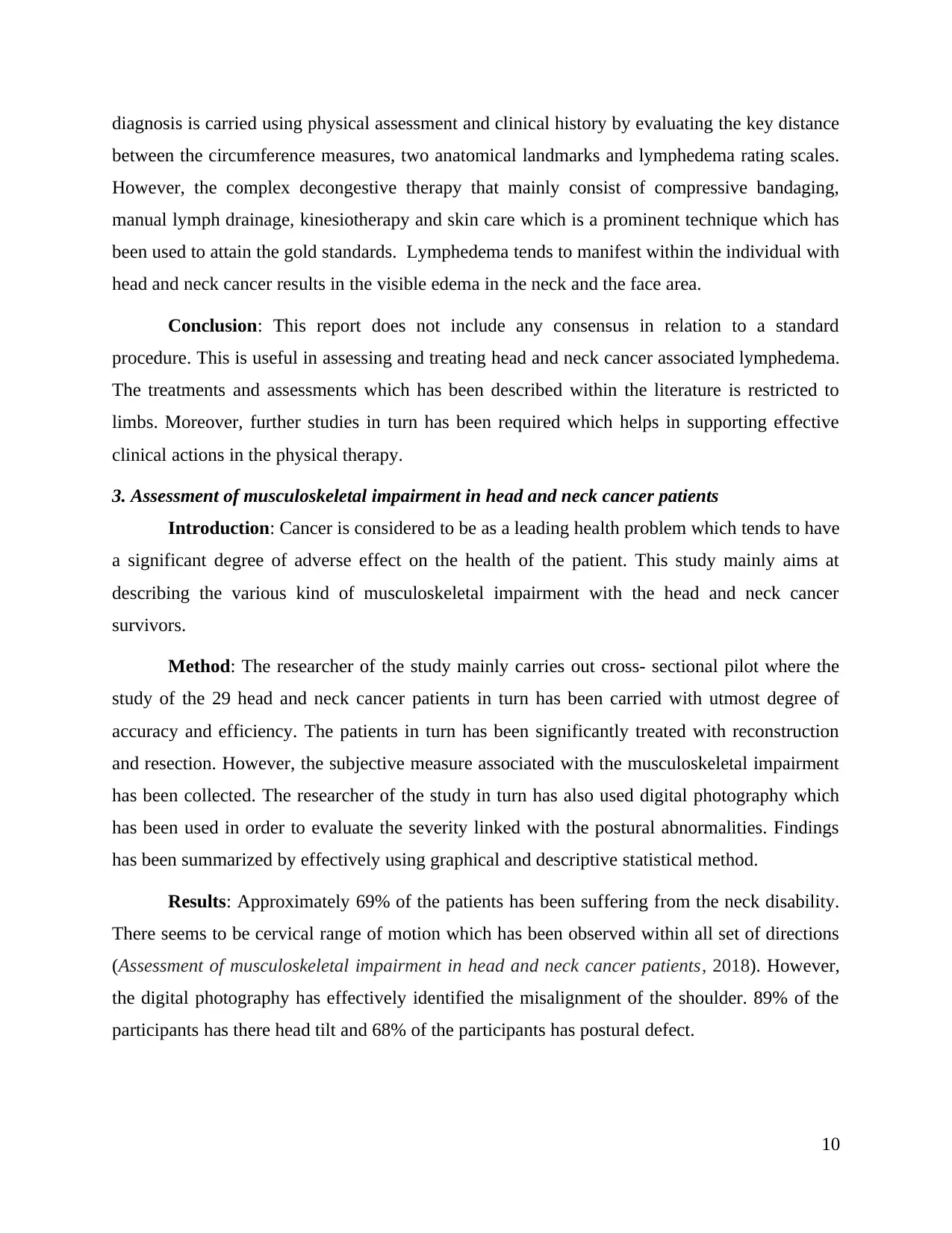
diagnosis is carried using physical assessment and clinical history by evaluating the key distance
between the circumference measures, two anatomical landmarks and lymphedema rating scales.
However, the complex decongestive therapy that mainly consist of compressive bandaging,
manual lymph drainage, kinesiotherapy and skin care which is a prominent technique which has
been used to attain the gold standards. Lymphedema tends to manifest within the individual with
head and neck cancer results in the visible edema in the neck and the face area.
Conclusion: This report does not include any consensus in relation to a standard
procedure. This is useful in assessing and treating head and neck cancer associated lymphedema.
The treatments and assessments which has been described within the literature is restricted to
limbs. Moreover, further studies in turn has been required which helps in supporting effective
clinical actions in the physical therapy.
3. Assessment of musculoskeletal impairment in head and neck cancer patients
Introduction: Cancer is considered to be as a leading health problem which tends to have
a significant degree of adverse effect on the health of the patient. This study mainly aims at
describing the various kind of musculoskeletal impairment with the head and neck cancer
survivors.
Method: The researcher of the study mainly carries out cross- sectional pilot where the
study of the 29 head and neck cancer patients in turn has been carried with utmost degree of
accuracy and efficiency. The patients in turn has been significantly treated with reconstruction
and resection. However, the subjective measure associated with the musculoskeletal impairment
has been collected. The researcher of the study in turn has also used digital photography which
has been used in order to evaluate the severity linked with the postural abnormalities. Findings
has been summarized by effectively using graphical and descriptive statistical method.
Results: Approximately 69% of the patients has been suffering from the neck disability.
There seems to be cervical range of motion which has been observed within all set of directions
(Assessment of musculoskeletal impairment in head and neck cancer patients, 2018). However,
the digital photography has effectively identified the misalignment of the shoulder. 89% of the
participants has there head tilt and 68% of the participants has postural defect.
10
between the circumference measures, two anatomical landmarks and lymphedema rating scales.
However, the complex decongestive therapy that mainly consist of compressive bandaging,
manual lymph drainage, kinesiotherapy and skin care which is a prominent technique which has
been used to attain the gold standards. Lymphedema tends to manifest within the individual with
head and neck cancer results in the visible edema in the neck and the face area.
Conclusion: This report does not include any consensus in relation to a standard
procedure. This is useful in assessing and treating head and neck cancer associated lymphedema.
The treatments and assessments which has been described within the literature is restricted to
limbs. Moreover, further studies in turn has been required which helps in supporting effective
clinical actions in the physical therapy.
3. Assessment of musculoskeletal impairment in head and neck cancer patients
Introduction: Cancer is considered to be as a leading health problem which tends to have
a significant degree of adverse effect on the health of the patient. This study mainly aims at
describing the various kind of musculoskeletal impairment with the head and neck cancer
survivors.
Method: The researcher of the study mainly carries out cross- sectional pilot where the
study of the 29 head and neck cancer patients in turn has been carried with utmost degree of
accuracy and efficiency. The patients in turn has been significantly treated with reconstruction
and resection. However, the subjective measure associated with the musculoskeletal impairment
has been collected. The researcher of the study in turn has also used digital photography which
has been used in order to evaluate the severity linked with the postural abnormalities. Findings
has been summarized by effectively using graphical and descriptive statistical method.
Results: Approximately 69% of the patients has been suffering from the neck disability.
There seems to be cervical range of motion which has been observed within all set of directions
(Assessment of musculoskeletal impairment in head and neck cancer patients, 2018). However,
the digital photography has effectively identified the misalignment of the shoulder. 89% of the
participants has there head tilt and 68% of the participants has postural defect.
10
⊘ This is a preview!⊘
Do you want full access?
Subscribe today to unlock all pages.

Trusted by 1+ million students worldwide
1 out of 32
Related Documents
Your All-in-One AI-Powered Toolkit for Academic Success.
+13062052269
info@desklib.com
Available 24*7 on WhatsApp / Email
![[object Object]](/_next/static/media/star-bottom.7253800d.svg)
Unlock your academic potential
Copyright © 2020–2025 A2Z Services. All Rights Reserved. Developed and managed by ZUCOL.





